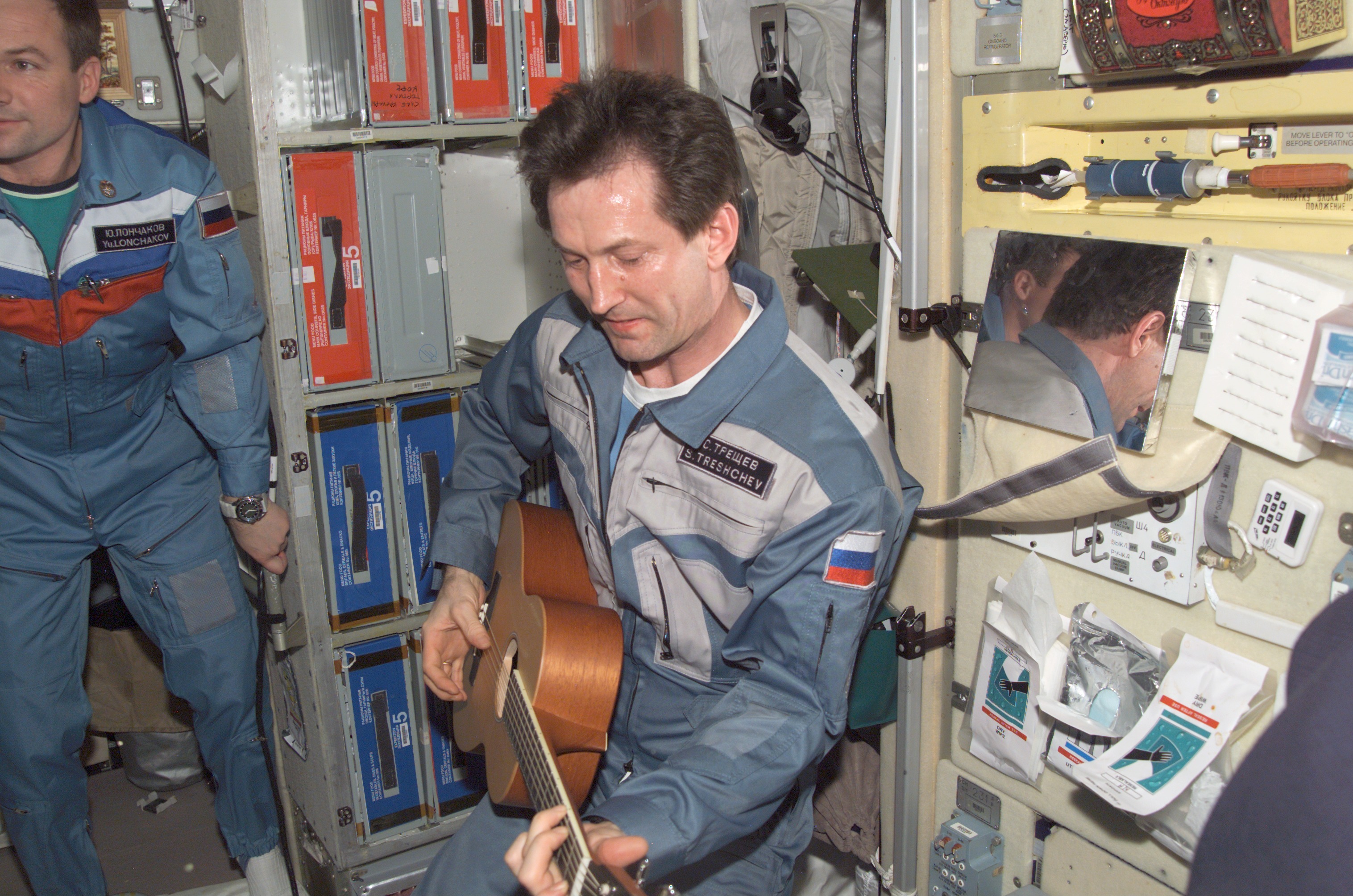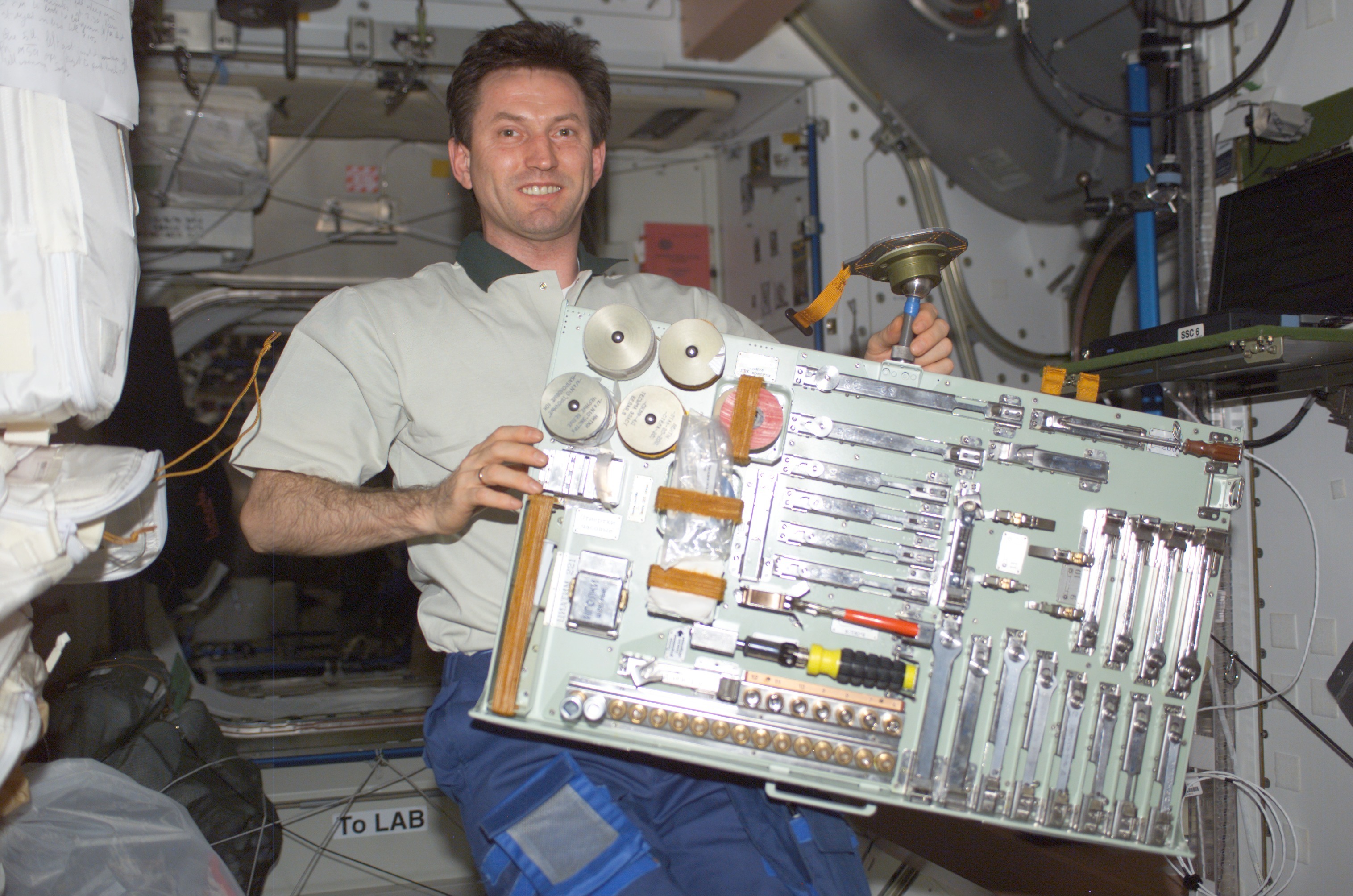Sergei Treshchov on:
[Wikipedia]
[Google]
[Amazon]
Sergey Yevgenyevich Treshchov (russian: Сергей Евгеньевич Трещёв; born 18 August 1958) is a former
 In 1992, he enrolled in the RSC Energia cosmonaut detachment, and from 1992 to 1994 he completed the basic Cosmonaut training course. Treshchov spent the next 3 years (1994 to 1996) in advanced Test Cosmonaut training.
From June 1997 to February 1998, Treshchov trained as a flight engineer for the Mir station backup Exp-25 crew. From June 1999 to July 2000 he trained as a flight engineer for the
In 1992, he enrolled in the RSC Energia cosmonaut detachment, and from 1992 to 1994 he completed the basic Cosmonaut training course. Treshchov spent the next 3 years (1994 to 1996) in advanced Test Cosmonaut training.
From June 1997 to February 1998, Treshchov trained as a flight engineer for the Mir station backup Exp-25 crew. From June 1999 to July 2000 he trained as a flight engineer for the

NASA site
{{DEFAULTSORT:Treshchov, Sergei 1958 births Living people Russian cosmonauts Heroes of the Russian Federation Crew members of the International Space Station Moscow Power Engineering Institute alumni Space Shuttle program astronauts Spacewalkers
cosmonaut
An astronaut (from the Ancient Greek (), meaning 'star', and (), meaning 'sailor') is a person trained, equipped, and deployed by a human spaceflight program to serve as a commander or crew member aboard a spacecraft. Although generally r ...
of the RSC Energia
PAO S. P. Korolev Rocket and Space Corporation Energia (russian: Ракетно-космическая корпорация «Энергия» им. С. П. Королёва, Raketno-kosmicheskaya korporatsiya "Energiya" im. S. P. Korolyov ...
. He spent 184 days in space as a flight engineer of the International Space Station
The International Space Station (ISS) is the largest Modular design, modular space station currently in low Earth orbit. It is a multinational collaborative project involving five participating space agencies: NASA (United States), Roscosmos ( ...
long duration Expedition 5
Expedition 5 was the fifth long-duration stay on the International Space Station (ISS). The crew, consisting of three people, remained in space for 184 days, 178 of which were spent aboard the ISS. Expedition 5 was a continuation of an uninterru ...
crew. During the mission he also conducted a spacewalk.
Personal
Treshchov was born in Volynsky District, in theLipetsk
Lipetsk ( rus, links=no, Липецк, p=ˈlʲipʲɪtsk), also romanized as Lipeck, is a city and the administrative center of Lipetsk Oblast, Russia, located on the banks of the Voronezh River in the Don basin, southeast of Moscow. Popu ...
Region of Russia. His father is Evgueniy Georgievich Treshchov, his mother is Nina Davydovna Treshchova. Treshchov and his wife, Elvira Viktorovna Treshchova have two sons, Dmitriy born in 1988 and Aleksey born in 1992. His hobbies include soccer, volleyball, ice hockey, hiking, tennis, music, photography, and video.
Education
In 1976 Treshchov graduated from technical school as an electric welder. In 1982 he graduated from the Moscow Power Institute specializing in "engineer-teacher of electrical power disciplines".Experience
From 1982 to 1984, Treschov served as a group leader in anAir force
An air force – in the broadest sense – is the national military branch that primarily conducts aerial warfare. More specifically, it is the branch of a nation's armed services that is responsible for aerial warfare as distinct from an ...
regiment. He worked as a foreman and as an engineer at the RSC Energia from 1984 to 1986. His responsibilities included the analysis and planning of cosmonaut activities aboard a space station
A space station is a spacecraft capable of supporting a human crew in orbit for an extended period of time, and is therefore a type of space habitat. It lacks major propulsion or landing systems. An orbital station or an orbital space station ...
and their inflight technical training. He also developed technical documentation and, together with the Yuri Gagarin Cosmonaut Training Center
The Yuri A. Gagarin State Scientific Research-and-Testing Cosmonaut Training Center (GCTC; Russian: Центр подготовки космонавтов имени Ю. А. Гагарина) is a Russian training facility responsible for trai ...
, coordinated all facets of cosmonaut training. His duties also included crew support and training for descent and emergency escape scenarios aboard the Mir
''Mir'' (russian: Мир, ; ) was a space station that operated in low Earth orbit from 1986 to 2001, operated by the Soviet Union and later by Russia. ''Mir'' was the first modular space station and was assembled in orbit from 1986 to&n ...
space station. He also participated as a test operator during tests of the ground-based complex to optimize the Life Support System of ЭУ367/734.
Cosmonaut career
 In 1992, he enrolled in the RSC Energia cosmonaut detachment, and from 1992 to 1994 he completed the basic Cosmonaut training course. Treshchov spent the next 3 years (1994 to 1996) in advanced Test Cosmonaut training.
From June 1997 to February 1998, Treshchov trained as a flight engineer for the Mir station backup Exp-25 crew. From June 1999 to July 2000 he trained as a flight engineer for the
In 1992, he enrolled in the RSC Energia cosmonaut detachment, and from 1992 to 1994 he completed the basic Cosmonaut training course. Treshchov spent the next 3 years (1994 to 1996) in advanced Test Cosmonaut training.
From June 1997 to February 1998, Treshchov trained as a flight engineer for the Mir station backup Exp-25 crew. From June 1999 to July 2000 he trained as a flight engineer for the Soyuz-TM
The Soyuz-TM were fourth generation (1986–2002) Soyuz spacecraft used for ferry flights to the Mir and ISS space stations. The Soyuz spacecraft consisted of three parts, the Orbital Module, the Descent Module and the Service Module.
The fir ...
backup ISS contingency crew. Initially, he trained as backup to the ISS Expedition 3
Expedition 3 was the third expedition to the International Space Station. Commander Frank L. Culbertson Jr. was the only American crew member, and as such the only American not on Earth during the 9/11 attacks, which the crew photographed and vi ...
crew.
Expedition 5
TheExpedition 5
Expedition 5 was the fifth long-duration stay on the International Space Station (ISS). The crew, consisting of three people, remained in space for 184 days, 178 of which were spent aboard the ISS. Expedition 5 was a continuation of an uninterru ...
crew was launched on June 5, 2002 aboard STS-111
STS-111 was a space shuttle mission to the International Space Station (ISS) flown by Space Shuttle ''Endeavour''. STS-111 resupplied the station and replaced the Expedition 4 crew with the Expedition 5 crew. It was launched on 5 June 2002, fr ...
. lifted off from the Kennedy Space Center
The John F. Kennedy Space Center (KSC, originally known as the NASA Launch Operations Center), located on Merritt Island, Florida, is one of the National Aeronautics and Space Administration's (NASA) ten field centers. Since December 196 ...
LC-39A
Launch Complex 39A (LC-39A) is the first of Launch Complex 39's three launch pads, located at NASA's Kennedy Space Center in Merritt Island, Florida. The pad, along with Launch Complex 39B, were first designed for the Saturn V launch vehicle. T ...
at 21:22:49 UTC. After two days ''Endeavour'' docked with the International Space Station
The International Space Station (ISS) is the largest Modular design, modular space station currently in low Earth orbit. It is a multinational collaborative project involving five participating space agencies: NASA (United States), Roscosmos ( ...
(ISS) on June 7, 2002 at 16:25 UTC. Treshchov joined the Expedition 5 crew as a flight engineer. The Expedition 5 crew carried out approximately 25 new investigations on board the ISS, as well as continued with various science investigations begun before their stay. The scientific investigations aimed at studying cold plasma, crystal growth, radiation effects in the space and the human body. Some medical experiments involved blood, muscles, bones while the crew also conducted psychological experiments.
The Expedition 5 crew returned to Earth on December 7, 2002, aboard Space Shuttle ''Endeavour'' STS-113
STS-113 was a Space Shuttle mission to the International Space Station (ISS) flown by Space Shuttle '' Endeavour''. During the 14-day mission in late 2002, ''Endeavour'' and its crew extended the ISS backbone with the P1 truss and exchanged the ...
mission. The shuttle touched down at KSC Runway 33 at 19:38:25 UTC. Completing his second long duration spaceflight, Treshchev logged 184 days, 22 hours and 15 minutes in space.

Spacewalks
Treschov performed his first and only career spacewalk on August 26, 2002. The start of the spacewalk was delayed because of an air leak in the sealed hatches between the ''Pirs'' airlock and the ''Zvezda'' module. The problem was easily corrected but took Treshchov and fellow cosmonaut Valery Korzun almost a half-hour to step through the procedures and get ready to go outside. Despite the late start at 05:27 UTC, the two spacewalkers finished everything assigned to them on this spacewalk. Wearing RussianOrlan
orlan is an internationally recognized French artist.
She is not tied to any one material, technology, or artistic practice. She uses sculpture, photography, performance, video, 3D, video games, augmented reality, artificial intelligence, and ro ...
spacesuits Treschov and Korzun installed a frame on the outside of the ''Zarya'' module to house components for future spacewalk assembly tasks. They installed new material samples on a pair of Japanese Space Agency materials exposure experiments housed on the outside of ''Zvezda''. They installed devices on ''Zvezda'' that will simplify the routing of tethers during future assembly spacewalks. The two spacewalkers also improved future station amateur radio operations by adding two ham radio antennas on ''Zvezda''. The spacewalk was staged from the ''Pirs'' docking compartment airlock and lasted 5 hours and 21 minutes.
References
External links
NASA site
{{DEFAULTSORT:Treshchov, Sergei 1958 births Living people Russian cosmonauts Heroes of the Russian Federation Crew members of the International Space Station Moscow Power Engineering Institute alumni Space Shuttle program astronauts Spacewalkers